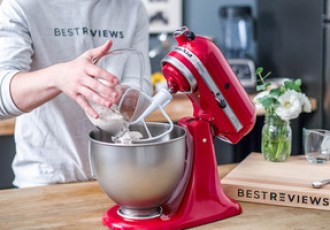We recommend these products based on an intensive research process that's designed to cut through the noise and find the top products in this space. Guided by experts, we spend hours looking into the factors that matter, to bring you these selections.

Chopping up onions or vegetables for your next round of meal prep? Without a sharp knife, you won’t get very far. A quality knife allows cooks to slice through foods easily, without resistance. Investing in a good set of knives will lead to a much easier food prep experience. Why not consider adding a ceramic knife or knife set to your arsenal of kitchen tools?
A ceramic knife is a long-lasting practical kitchen tool for cooks of all levels. Ceramic knives are incredibly durable and feature sharp precision blades for a relatively low price tag compared to other types of knives. Ceramic blades aren’t as delicate as ceramic dishware but should still be handled with care. These tough knives are prone to chipping if used to chop hard food items, but they’re ideal for cutting bread, soft cheeses, and certain meats. A low-maintenance ceramic knife is also perfect for the time-pressed home chef since it requires little upkeep.

Why choose a knife with a ceramic blade over one made of steel? Here are a few pros involved in owning a ceramic knife.
Yes, there are cons, too. So, why not have a kitchen outfitted with solely ceramic knives? Ceramic doesn’t do well against hard surfaces like bone and may chip if mishandled and dropped. If you want to cut bone-in meat, you’ll need a knife with a steel blade.
Here are some ways to help you determine if you only need one ceramic knife or a set.
You might only need a single knife if:
You will only use it for one or two purposes/on similar foods.
You don’t need a knife block or other place to store your knives.
You already have a comprehensive set of knives.
You aren’t sure how you will like ceramic (vs. steel knives).
You might need a set if:
You will use them all for a variety of foods with different textures and sizes.
You need a knife block to store them in.
You’re gifting knives to someone just starting their own home kitchen.
You’ll find any number of knife types available in ceramic form. The kind of knife you buy depends on your needs in the kitchen. Looking for a knife to cut up bread? Shop for a serrated bread knife. Need it to finely dice vegetables, herbs, and spices? You’ll need a knife that’s sharp and precise. Here are the essential knives any home cook should have at their disposal:

Here are some of the features you may find in a ceramic knife or set of knives.
A comfortable handle is essential, especially for cooks who will spend a lot of time chopping, slicing, and dicing. A handle should also be grippy to prevent slippage that may cause kitchen accidents.
Ceramic knife blades are sharp but delicate. Proper housing prevents damage and chipping. To be sure that your knives stay intact for a long time, choose a knife or knife set with some type of housing (e.g., knife block or sheath).
If you are storing your knives in a drawer, block, or case, it can be tough to spot the one you need at a quick glance. Knives that are color-coded make it easier to find the knife you need quickly. Some knives even feature etched-in labels that help you identify the right blade for the task at hand (e.g., cheese knife, pizza knife, etc.).
Style only matters if you’ll be leaving your knives on display. If you house your ceramic set on your counter, choose a knife block that fits with your kitchen decor. Prefer to store your knives on a magnetic strip? Pick knives that fit your aesthetic.

Purchasing a ceramic knife set will typically set you back more than buying a single knife, but building a set of knives by buying each one individually will be more expensive in the long run.
You can find inexpensive ceramic knives, even sets, for under $25. Costlier sets will likely include higher-grade ceramic and better-designed handles. High-quality ceramic knives will cost at least $50 and usually contain at least three knives. We recommend spending in the mid- to high-priced range if you plan to use the knives often and want them to last a while.

A. Because ceramic is a very hard material, you’ll need a diamond sharpener. You could try to very carefully use a regular sharpener designed for sharpening steel knives, but you’ll likely end up with a chipped blade. The good news is that ceramic blades tend to stay sharp for a long time if used properly, so maintaining a sharp edge isn’t an issue and requires little maintenance. If your blade is getting dull, you can send it off to a professional for sharpening. Otherwise, we recommend a specialty sharpener.
A. Use the top rack of the dishwasher, lay it flat, and keep other dishes away from your knife to prevent accidental chipping.
A. This depends entirely on what types of knives you already have on hand. Buying single knives will be more expensive in the long run, but if you already have a filled knife block and merely want a durable new slicing utensil, buying an individual knife is the way to go. If you’re outfitting your newly moved-into kitchen, a full set will be more economical. Note that you’ll need to buy non-ceramic knives for other tasks, like cutting bone-in meats.
Get emails you’ll love.
Learn about the products you’re wondering if you should buy and get advice on using your latest purchases.
